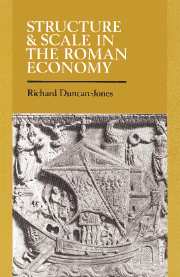Book contents
- Frontmatter
- Contents
- List of figures
- List of tables
- Preface
- List of abbreviations
- Introduction
- PART I TIME AND DISTANCE
- PART II DEMOGRAPHY AND MANPOWER
- 5 Age-awareness in the Roman world
- 6 Roman life–expectancy
- 7 Pay and numbers in Diocletian's army
- PART III AGRARIAN PATTERNS
- PART IV THE WORLD OF CITIES
- PART V TAX-PAYMENT AND TAX-ASSESSMENT
- Appendices
- Bibliography
- Index
7 - Pay and numbers in Diocletian's army
Published online by Cambridge University Press: 13 October 2009
- Frontmatter
- Contents
- List of figures
- List of tables
- Preface
- List of abbreviations
- Introduction
- PART I TIME AND DISTANCE
- PART II DEMOGRAPHY AND MANPOWER
- 5 Age-awareness in the Roman world
- 6 Roman life–expectancy
- 7 Pay and numbers in Diocletian's army
- PART III AGRARIAN PATTERNS
- PART IV THE WORLD OF CITIES
- PART V TAX-PAYMENT AND TAX-ASSESSMENT
- Appendices
- Bibliography
- Index
Summary
The Beatty papyri originally consisted of two long rolls containing a day-to-day transcript of high-level correspondence sent to Panopolis in AD 298–300 by the authorities governing the Thebaid. The long series of letters, whose frequent refrain is the failure of subordinates to carry out instructions, gives the most graphic impression of Roman provincial government in action; and the dossier is in its way as important as Pliny's correspondence with Trajan two hundred years earlier.
The letters used here describe payments to ten different army units stationed in the Thebaid, which together made up a large part of the garrison of southern Egypt. Because they contain instructions to pay, the letters specify unit, amount, type of payment and period covered. If in a single case either the rate or the number of recipients can be convincingly identified, much wider information about unit–strengths and military spending under Diocletian potentially becomes available.
In an important pioneering discussion, A.H.M. Jones analysed the payments in money, using smallest round-figure denominators and common denominators. His results suggested that unit-strengths were relatively high, but that the basic rates of army pay (stipendium) late in Diocletian's reign were still what they had been early in the third century.
His interpretation, although based on ingenious analysis, and orthodox in some of its results, is not entirely convincing (Appendix 5).
- Type
- Chapter
- Information
- Structure and Scale in the Roman Economy , pp. 105 - 118Publisher: Cambridge University PressPrint publication year: 1990
- 1
- Cited by



